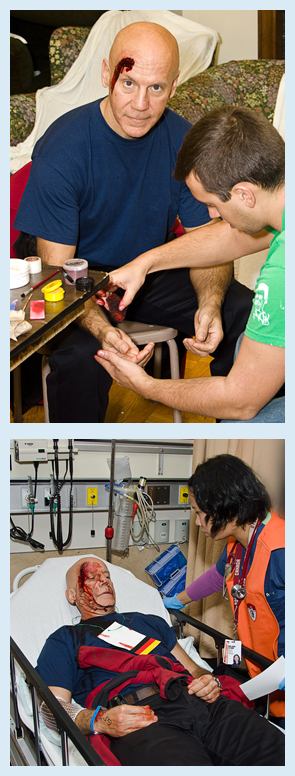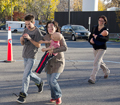Code Orange Simulation
At 8:35 a.m. October 24, 2012, a simulated Code Orange emergency incident was declared in Montreal. More than 100 actors, dressed and made-up to appear as injured patients, were brought by ambulance and city bus to the Emergency Departments (ED) of the Montreal General Hospital (MGH) and Montreal Children’s Hospital (MCH). The simulation was designed to evaluate the emergency preparedness of Montreal services should a major event really occur.
The MUHC was invited to participate in this unique opportunity with the Agence de la santé et des services sociaux de Montréal, the Corporation d’Urgences-Santé, le Service de police de la Ville de Montréal, the Montreal Transit System and the Canadian Forces. With nearly 40 medical and paramedical disciplines, the Montreal General and Montreal Children’s Hospitals deliver ultra-specialized trauma care for adults and children in Quebec – the only institutions providing such care in downtown Montreal. Each year the MUHC receives approximately 10,000 trauma victims, including more than 1,500 who present with injuries sufficiently serious to involve intensive care, surgery and rehabilitation.
What is a Code Orange?
A Code Orange is recognized by healthcare centres in Quebec and elsewhere as a signal that a catastrophe or external emergency has occurred which may result in multiple casualties.
The Making of a Code Orange Simulation Event
About a year before it was scheduled to take place, the MUHC began discussions with the Agence de la santé et des services about executing a Code Orange simulation, which would offer an extraordinary opportunity for the MUHC to test and assess its procedures. Very few people were to be aware of the simulation to ensure the maximum number of MUHC employees would respond as if it were a real Code Orange event.
Day of the Code Orange Simulation
 In the early hours of October 24th, military artists made up approximately 100 actors of different ages to appear to have realistic-looking wounds on their faces and bodies. The actors then boarded city buses and ambulances bound for MUHC hospitals.
In the early hours of October 24th, military artists made up approximately 100 actors of different ages to appear to have realistic-looking wounds on their faces and bodies. The actors then boarded city buses and ambulances bound for MUHC hospitals.
At 8.35 a.m., the Agence launched the Code Orange simulation. The MUHC Call Centre began contacting department leaders throughout the institution in accordance with Code Orange procedures.
As the ambulances made their way to the hospital, they called into the EDs of both participating hospitals to advise them on the number of patients they were bringing in and their status. The blue trauma light flashed, alerting the ED teams to prepare for the arrival of patients.
Within minutes of the Code Orange being called, the ambulances and city buses were rushing to the MGH and MCH EDs carrying “patients” in various states of injury. The EDs kicked into high gear as the “patients” were brought in, assessed, “treated” and released. The hospital kept the media up-to-date with communiqués, press conferences and diligent use of social media such as Twitter.
The Agence filmed the entire event with the intention of using the film as a teaching tool for Quebec hospitals. The event, which provided a rare opportunity to test and evaluate preparedness on such as large scale, lasted about five hours and touched many different MUHC departments, including the EDs, Trauma, the Intensive Care Unit, Housekeeping, Public Affairs, and many more. The entire process ran smoothly and with precision, all the while ensuring real patients continued to be properly seen. The MUHC was lauded by the Agence for its efficiency and professionalism – a testament to the dedication and team work of the hospital’s staff and physicians.
A brief history of Code Oranges at the MUHC
The MUHC is always prepared for a possible Code Orange – the signal that alerts the hospital of an external incident that could result in mass casualties. Scheduled events such as the U2 concert in the summer of 2011 or last spring’s student demonstrations triggered, a pre-Code Orange which ensured hospitals were on stand-by during these massively attended events. Unexpected events that take place elsewhere, such as the earthquake in Haiti, can also trigger a Code Orange if some casualties are expected to be brought to the MUHC. The last major Code Orange that took place was in 2006 following the Dawson shootings. Since then, the MUHC has initiated pre-Code Orange procedures several times, including the full-scale simulation this past autumn.
What the public should do during a Code Orange
If you require hospital treatment that is not urgent during a Code Orange, consider visiting your nearest health care resource or call Info Santé at 811.
For up to the minute information and to find out which hospitals are affected, check the Agence’s website:
www.facebook.com/santemontreal
To find out if a Code Orange is called at the MUHC, go to:
www.muhc.ca or follow us on Twitter at www.twitter.com/cusm_muhc
Partners involved and their roles during the drill
- Agence de la santé et des services sociaux de Montréal: evaluate the network coordination structure
- Canadian Armed Forces: prepare the volunteer victims (makeup)
- Urgences-santé: transport volunteer victims and evaluate the transfer of casualties as ambulances arrive at the hospital
- MUHC: receive and treat the wounded (e.g., validate the triage protocol and validate the intra-hospital patient transfer process)
- Service de police de la Ville de Montréal: evaluate crowd control around the site Société de transport de Montréal: evaluate the transportation of victims by bus










